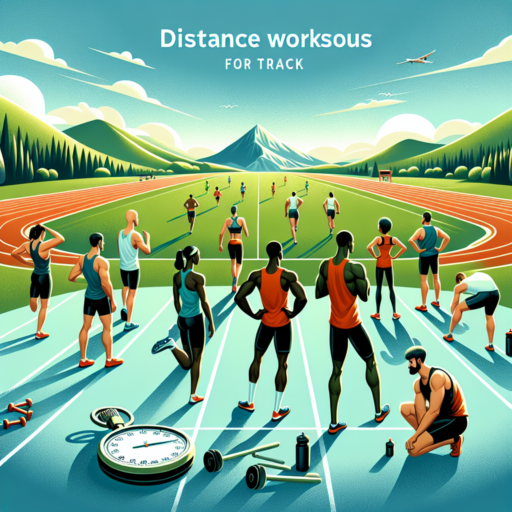What is Running on Track and Why It Matters
Running on a track refers to the activity of jogging or sprinting on a specially designed circular path, often found in sports stadiums and athletic fields. This form of exercise is known for its structured environment, which allows for precise measurement of distance and time, making it a favorite among athletes and fitness enthusiasts alike. Running on track stands out from other forms of running due to its consistent surface and the absence of obstacles, providing a controlled setting for performance improvement and injury prevention.
Benefits of Running on Track
One of the key reasons why running on track matters is the myriad of benefits it offers. Firstly, the even and predictable surface of a track reduces the risk of tripping and falling, minimizing the chances of injuries that are common in road running. Moreover, tracks are designed with materials that absorb impact better than concrete or asphalt, offering a gentler option for your joints. Secondly, tracks often come equipped with facilities such as locker rooms and showers, enhancing the overall running experience. Finally, the communal aspect of track running fosters a supportive environment, encouraging consistency and motivation among runners.
Training Precision and Improvement
Furthermore, running on a track allows for unparalleled precision in training. The measured distances of track lanes provide an accurate means to gauge speed, endurance, and overall progress. This facilitates targeted training sessions, such as interval trainings or speed work, which are essential for improving race times and enhancing cardiovascular health. Additionally, the clear demarcations of a track enable runners to set and achieve specific goals, leading to a more structured and rewarding running regimen.
The Essential Gear for Running on Track
Preparing for track running involves more than just determination and training schedules; having the right gear is crucial for both performance and injury prevention. From shoes designed specifically for the track to breathable clothing that keeps you comfortable, understanding what to equip yourself with can significantly impact your running experience.
Choosing the Right Footwear
Selecting the right shoes is paramount for any track runner. Track shoes, often referred to as spikes, offer enhanced grip and stability on the track surface, aiding in faster acceleration and improved overall performance. It’s essential to choose a pair that fits well, supports your arch type, and matches the specific requirements of your events, whether they’re sprints, middle-distance, or distance races.
Appropriate Running Attire
Equally important is wearing suitable attire that facilitates optimal performance. Opt for lightweight, moisture-wicking fabrics that keep you dry and comfortable throughout your run. Items such as running shorts, a breathable top, and compression wear can help in reducing drag and supporting your muscles, respectively. Remember, your choice of clothing can affect your aerodynamics and comfort on the track.
Must-Have Accessories
Beyond shoes and clothing, small accessories can make a significant difference in your running regimen. A high-quality pair of running socks can prevent blisters, whereas a hat or visor can protect you from the sun on outdoor tracks. Don’t overlook the importance of a good hydration pack or belt, especially for longer distance training sessions, to stay adequately hydrated without breaking your stride.
Preparing for Your First Run on Track: A Beginner’s Guide
Embracing the challenge of your first track run can be exhilarating and a tad daunting. This beginner’s guide will impart crucial advice, ensuring that your initial foray onto the running track is both enjoyable and productive. Fret not, as navigating this new terrain is a journey worth embarking upon.
Choosing the Right Gear
The significance of selecting appropriate gear cannot be overstressed for your first track run. First and foremost, investing in a pair of running shoes that offer adequate support and comfort is essential. Unlike street running, track surfaces can be firmer, necessitating footwear that can absorb shock effectively. Additionally, don lightweight, breathable clothing that will help manage your body temperature and reduce any potential for chafing. Remember, comfort is key to maintaining focus and performance on the track.
Understanding Basic Track Etiquette
Before stepping foot on the track, familiarize yourself with basic etiquette. Tracks often have rules about which lanes are reserved for jogging, sprinting, or walking. Typically, the inner lanes are for faster runners or those doing interval work, while the outer lanes cater to joggers and walkers. Being aware of your surroundings and signaling when moving across lanes can minimize disruptions and ensure safety for everyone on the track. Embrace these courtesies, and you’ll blend seamlessly into the track running community.
Approaching your first run with preparation and respect for the process will set the stage for a rewarding experience. Keep these guidelines in mind as you lace up your running shoes and take that exhilarating first step onto the track. Remember, every runner’s journey starts with a single lap, and this is the beginning of yours.
No se han encontrado productos.
10 Tips to Improve Your Running on Track Performance
Improving your performance on the track requires a blend of technique, discipline, and the right mindset. Whether you’re a seasoned athlete looking to shave off a few seconds from your personal best or a newcomer eager to hit the ground running, these 10 tips are designed to steer you in the right direction. Let’s dive into how you can elevate your running game and leave your competition in the dust.
Optimize Your Warm-Up Routine
Starting your training with a targeted warm-up is crucial for enhancing performance and preventing injuries. Focus on dynamic stretches that mimic running movements to prepare your muscles and joints. Integrating drills such as high knees, butt kicks, and leg swings can significantly improve your flexibility and efficiency on the track.
Incorporate Interval Training
To boost your speed and endurance, integrate interval training into your regimen. Alternating between high-intensity sprints and recovery periods not only increases your aerobic capacity but also teaches your body to recover more efficiently. Utilize the track’s markings to your advantage, using them to gauge your sprint lengths and recovery walks or jogs. This methodical approach to pushing your limits can lead to remarkable improvements in overall performance.
Refine Your Running Technique
- Posture: Maintain an upright posture with a slight forward lean to promote efficiency and speed.
- Footwork: Aim for a mid-foot strike to minimize impact forces and maintain momentum.
- Breathing: Develop a rhythmic breathing pattern to improve oxygen flow and endurance.
- Arm Swing: Use your arms to propel you forward, keeping them bent at a 90-degree angle and moving in sync with your legs.
By refining these aspects of your running technique, you can improve your pace, reduce the risk of injury, and enhance your overall track performance. Remember, consistency is key. Incorporate these tips into your routine, and you’ll see substantial gains in your running efficiency and speed.
The Physical and Mental Benefits of Running on Track
Running on a track provides a myriad of physical and mental benefits that can enhance your overall well-being. Engaging in this form of exercise regularly not only improves your cardiovascular health but also boosts your mental state, making it a beneficial activity for both your body and mind.
Improvement in Cardiovascular Health
Primarily, running on a track significantly boosts your cardiovascular health. This form of exercise gets your heart rate up, promoting better blood circulation throughout your body. Regular runners often experience lower blood pressure, reduced risk of heart diseases, and improved heart function. Notably, the rhythmic nature of running helps in strengthening the heart muscles, making it more efficient in pumping blood. Additionally, the controlled environment of a track minimizes the risk of injuries, allowing runners to maintain a consistent workout regime that contributes to a healthier heart.
Enhancement of Mental Health
Beyond the physical benefits, running on a track offers profound mental health advantages. The act of running can trigger the release of endorphins, known as ‘feel-good’ hormones, which can create feelings of euphoria and a general state of well-being. This makes running an effective way to combat stress, anxiety, and depression. Furthermore, running in the open environment of a track, with its repetitive laps, allows for a form of moving meditation, helping to clear the mind and foster a sense of peace and focus. This meditative aspect can significantly improve mental clarity and emotional stability.
Promotion of Joint and Muscular Strength
Regular track running also aids in reinforcing joint and muscular strength. The smooth, soft surface of most tracks is kinder on the joints compared to running on roads or trails. This can lead to a lower risk of joint-related injuries and conditions like arthritis in the long term. Moreover, the repetitive motion of running helps in building muscular endurance, particularly in the lower body, including the quadriceps, hamstrings, glutes, and calves. This not only makes you stronger but also improves your posture and balance. Consistency in your running routine is key to reaping these physical benefits, reinforcing the importance of regularity and discipline in your exercise regimen.
Understanding Track Etiquette for Runners
Mastering track etiquette is essential for any runner, whether novice or veteran, to ensure a respectful and safe environment for everyone using the track. Grasping the unwritten rules helps maintain harmony and prevent accidents. Let’s dive into some of the fundamental etiquettes that every runner should know.
The Importance of Lane Usage
One of the cardinal rules of track etiquette revolves around appropriate lane usage. Typically, the inside lanes are reserved for faster runners or those doing speed work, while the outer lanes are designated for slower-paced runners or joggers. Adhering to this arrangement maximizes efficiency for all users and reduces the risk of collisions or disruptions in pace.
Passing Etiquette
Another crucial aspect of track etiquette is knowing how to pass correctly. It’s general courtesy to pass on the left, signaling if necessary, and ensuring there’s ample space to do so without disrupting the pace of the runner being overtaken. Achieving a seamless pass involves a brief acceleration and a glance over your shoulder to avoid cutting off the other runner too closely.
How to Choose the Right Track Shoes
When selecting the right track shoes, it’s crucial to consider several factors to enhance your performance on the track. The perfect pair can significantly affect your speed, comfort, and stability, ensuring you’re equipped to take on any challenge during your race.
Determining Your Foot Type and Shoe Fit
First and foremost, identifying your foot type is essential. Whether you have a high arch, flat feet, or a neutral arch affects which shoe will provide the best support. Additionally, finding a shoe that fits well is paramount. The shoe should snugly fit around your midfoot while allowing some room in the toe box to accommodate natural foot expansion during runs.
Understanding the Different Types of Track Shoes
Track shoes are specialized footwear designed for various track events, including sprints, distance runs, and field events. Each type caters to specific needs: sprint spikes offer a lightweight construction and minimal cushioning for speed and efficiency, while distance spikes feature more cushioning and support for endurance events. Field event shoes are designed with specific functions in mind, such as additional support for the high jump or optimal grip for throwing events.
Selecting the right track shoes involves understanding your personal needs, preferences, and the type of events you will participate in. Considering these factors will guide you to a pair that not only boosts your performance but also protects you from injury, ensuring that every step you take on the track is as efficient and comfortable as possible.
Track vs. Road Running: What’s the Difference?
When it comes to running, the surface you choose can significantly impact your experience, performance, and even your body. Track and road running are two of the most popular surfaces runners opt for, each offering unique advantages and challenges. Understanding the key differences between these surfaces can help runners make informed decisions about their training routines.
Surface Impact and Body Influence
One of the primary differences between track and road running lies in the surface impact. Track surfaces, typically made of synthetic rubber, offer a softer impact compared to the hard asphalt or concrete of road surfaces. This reduced impact on tracks can lead to a lower risk of stress injuries, making it a suitable option for those recovering from injuries or looking to avoid them. However, the repetitive nature of running in circles can introduce its own set of strain injuries, especially on the hips and IT band.
Variability and Mental Stimulation
Road running excels in offering a constantly changing environment, which can be mentally stimulating and help keep boredom at bay. Runners are exposed to different elevations, scenery, and challenges that can enhance the overall running experience. In contrast, track running involves multiple laps around the same loop, which can become monotonous but allows for consistent pacing and the ability to closely monitor performance. This environment is ideal for focused training sessions, where specific performance metrics are the primary goal.
Incorporating Interval Training in Track Running
Interval training has become a cornerstone method for athletes looking to enhance their track running performance. By integrating short, high-intensity bursts of speed with slower, recovery phases, runners can significantly improve their aerobic capacity and endurance. This method not only boosts speed but also increases metabolic efficiency, making it an indispensable part of a runner’s training routine.
The beauty of interval training lies in its versatility. Runners can tailor the duration, pace, and recovery times of their intervals to match their specific goals, whether they’re aiming to increase speed, improve endurance, or both. For example, a common interval workout might consist of 400-meter sprints followed by 400-meter jogs. This format can be adjusted in countless ways to challenge the athlete and stimulate improvement.
Another essential component of successful interval training is monitoring and progression. Keeping track of times, distances, and overall effort during each session can provide valuable insights into a runner’s development. Over time, increasing the intensity or volume of intervals can lead to significant gains in performance. Furthermore, incorporating variety in interval workouts, such as changing the length or speed of intervals, prevents training plateaus and keeps the regimen engaging.
Upcoming Track Running Events and How to Participate
Participating in track running events is an exciting way to challenge yourself, meet other runners, and enjoy the competitive atmosphere of racing. Whether you’re a seasoned athlete or new to the scene, there’s a place for you in the upcoming races. Here’s how you can become part of this exhilarating world.
Finding the Right Event
Start by researching track meets that cater to your level of experience and preferred distance. Websites dedicated to athletics, running clubs, and sports organizations often have calendars listing upcoming events. Look for races that provide a good match for your skills and goals. Many events offer categories for different age groups and skill levels, making them accessible to a wide range of participants.
Preparing for the Race
Once you’ve selected an event, it’s crucial to prepare adequately. This preparation involves not only stepping up your training but also ensuring you have the necessary gear. A good pair of running shoes, comfortable clothing that won’t restrict your movements, and a water bottle for hydration are essential. Additionally, familiarize yourself with the track layout and any rules specific to the event. This knowledge will help you feel more confident and improve your performance.
Registration Process
Registering for track running events is typically straightforward but requires attention to detail. Check the event’s official website for registration deadlines and fees. Some events offer online registration, whereas others may require you to sign up in person or through mail. Make sure to provide any requested information accurately to avoid any issues on race day. Once registered, mark the event date on your calendar and continue your training, focusing on your specific race goals.
Track running events are not only about the competition; they are also about personal growth, community, and sharing a love for running. By choosing the right event, preparing properly, and registering on time, you’re setting the stage for an unforgettable experience. Whether aiming to break your personal record or simply looking to complete your first race, the upcoming track running events offer a fantastic opportunity to achieve your goals.




